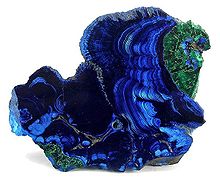Jahn-Teller effect
The Jahn-Teller effect , discovered in 1937, goes back to the scientists Edward Teller (1908–2003) and Hermann Arthur Jahn (1907–1979). The Jahn-Teller theorem explains the distortion in the geometry of the ligand field of some octahedral complex compounds along a spatial axis.
The theorem says:
"Every non-linear molecular system is unstable in a degenerate electronic state and splits the degenerate state by lowering the symmetry ."
The Jahn-Teller effect can also be observed in complexes with an octahedral structure, but does not lead to any structural changes. In particular, complexes with weak ligand fields are susceptible to Jahn-Teller distortions, so that in the strong ligand field a strong Jahn-Teller distortion can only be observed in octahedral d 7 low-spin complexes (t 6 2g e 1 g ).
Due to a distortion (Jahn-Teller distortion), two of the ligands occupy a greater or lesser distance from the central atom than the ligands in the equatorial plane of the complex compound. The quadratic planar coordination can be regarded as an extreme case of a Jahn-Teller distortion when the ligands are infinitely far away from the central atom along the z-axis.
The distortion turns out to be energetically favorable in the complexes concerned, since the occupied molecular orbitals are energetically lowered. Unoccupied molecular orbitals are energetically raised. The degeneracy is lost through the energetic splitting of the molecular orbitals .
A Jahn-Teller distortion (stretching or compression) occurs when there are groups of d-states due to the splitting of the ligand field, so that there is more than one possibility of the electron arrangement and this electron arrangement is energetically degenerate. Since degenerate states are unstable, the distortion removes the symmetry of the structure; the partially occupied orbitals of the same energy become orbitals of different energy. This means an energy gain because only the orbitals with lower energy are occupied. A distortion is e.g. B. for the electron arrangements d 4 -high-spin, as well as d 7 -low-spin and d 9 to be expected.
If there is now a high-spin complex, for example d 4 (t 3 2g e 1 g ), the fourth d electron can either occupy the d x²-y² or the d z² orbital of the same energy . If the d x²-y² orbital is occupied, the 4 equatorially arranged ligands are repelled, which results in a compression of the octahedron. If, on the other hand, the d z² orbital is occupied, only the two axially arranged ligands are repelled, which leads to a stretching of the octahedron in the z-direction. In both cases, the occupation of the lowered orbital leads to an energy gain, albeit not very large, which is referred to as the Jahn-Teller stabilization energy. Whether it is stretched or compressed depends, among other things, on the counterion. For example, a [Cu (NO) 6 ] 4− complex can be found either as an octahedral-compressed or as an octahedral-elongated complex, depending on the counterion. Others such as [Cu (py ') 6 ] 2+ with py' = pyridine oxide even have a structure that fluctuates between the two forms.
A very similar mechanism also occurs in one-dimensional chains of atoms and in solids; it is then referred to as Peierls' distortion .
The antiaromatic cyclobutadiene can be used as an example of such a distortion in organic chemistry . (See Frost-Musulin diagram )
consequences
Between the energy levels split up by the Jahn-Teller effect, the incidence of light can lead to electron transitions, with light of the corresponding wavelength being absorbed. This mechanism is primarily responsible for the color of various minerals, e.g. B. the green color of malachite and the blue color of azurite .
See also
literature
- HA Jahn, E. Teller: Stability of polyatomic molecules in degenerate electronic states. I. Orbital degeneracy . In: Proceedings of the Royal Society of London, Series A-Mathematical and Physical Sciences , Volume 161, 1937, pp. 220-235, JSTOR 96911 .
Individual evidence
- ↑ Gabriele Steffen: Color and Luminescence of Minerals. Introduction to the crystal chemical and crystal physical causes . Enke at Georg Thieme Verlag, Stuttgart / New York 2000.

